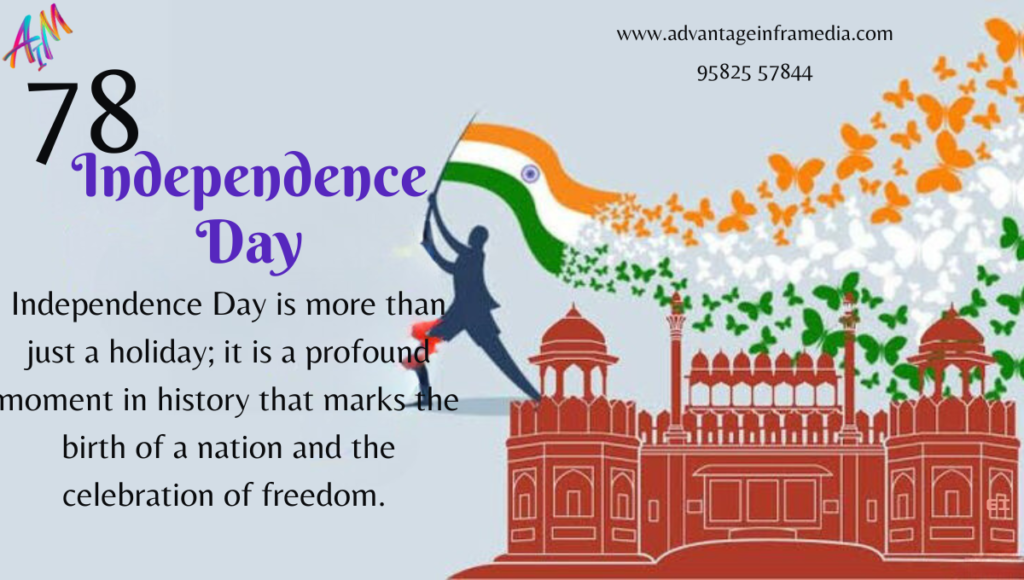Introduction
Independence Day is more than just a holiday; it is a profound moment in history that marks the birth of a nation and the celebration of freedom. Every year, countries around the world celebrate their independence, often with parades, fireworks, and speeches that reflect on the journey to sovereignty. For many, it is a day of pride, remembrance, and unity—a day to honor the sacrifices made by those who fought for freedom and to celebrate the values that define a nation.
In this blog, we will explore the significance of Independence Day, its historical roots, and how it is celebrated around the world. We will delve into the different ways countries commemorate this day, the symbols associated with it, and the importance of unity and patriotism. We will also reflect on how Independence Day serves as a reminder of the ongoing struggle for freedom and justice in various parts of the world.
The Historical Significance of Independence Day
Independence Day is a day that marks the end of colonial rule or the liberation from an oppressive regime. It is the culmination of years, if not decades, of struggle, resistance, and sacrifice. The historical significance of Independence Day varies from country to country, depending on the circumstances under which independence was achieved.
For instance, in the United States, Independence Day is celebrated on July 4th, commemorating the adoption of the Declaration of Independence in 1776. This document marked the beginning of the United States as a sovereign nation, free from British rule. The American Revolution was a war for independence, fought by ordinary citizens who believed in the principles of liberty, equality, and self-governance.
In India, Independence Day is celebrated on August 15th, marking the end of British colonial rule in 1947. The struggle for independence in India was long and arduous, characterized by non-violent resistance led by figures like Mahatma Gandhi. The Indian independence movement was not just a fight against colonialism but also a quest for social and economic justice for millions of Indians.
Similarly, countries in Africa, Asia, and Latin America have their own Independence Days, each with its unique history and significance. For many of these nations, independence came after years of struggle against colonial powers that exploited their resources and oppressed their people. Independence Day, therefore, is not just a celebration of freedom but also a reminder of the resilience and determination of those who fought for it.
The Spirit of Unity and Patriotism
Independence Day is a time for citizens to come together and celebrate the values that bind them as a nation. It is a day of unity, where people from all walks of life, regardless of their differences, come together to celebrate their shared identity and common goals. The spirit of unity is often reflected in the national symbols, such as the flag, the anthem, and the national emblem, which are prominently displayed during Independence Day celebrations.
Patriotism is at the heart of Independence Day. It is a day to express love and pride for one’s country, to honor the sacrifices made by the nation’s founders, and to reaffirm the commitment to the principles of freedom, justice, and equality. Patriotism on Independence Day is not just about waving flags and singing the national anthem; it is also about reflecting on the responsibilities that come with being a citizen of a free nation.
Independence Day is also a time for reflection. It is an opportunity to look back at the nation’s history, to remember the struggles and sacrifices that made independence possible, and to consider how far the nation has come since then. It is a day to reflect on the challenges that still lie ahead and to renew the commitment to building a better, more just, and more inclusive society.
Celebrations Around the World
Independence Day is celebrated in different ways around the world, depending on the cultural and historical context of each country. However, there are some common elements that are often seen in Independence Day celebrations, such as parades, fireworks, speeches, and cultural performances.
In the United States, Independence Day is a major national holiday, celebrated with parades, fireworks, barbecues, and concerts. The day typically begins with a flag-raising ceremony, followed by a parade that features marching bands, military units, and floats. Fireworks are a central part of the celebration, with displays taking place in cities and towns across the country. The day is also marked by patriotic speeches, often delivered by political leaders, and concerts featuring patriotic songs.
In India, Independence Day is celebrated with a grand flag-hoisting ceremony at the Red Fort in Delhi, followed by a speech by the Prime Minister. The speech typically highlights the achievements of the nation over the past year and outlines the government’s vision for the future. The day is also marked by cultural performances, including traditional dances and songs, and school children often participate in parades and other activities.
In countries like France, Independence Day is celebrated with military parades, such as the Bastille Day parade on July 14th, which is one of the oldest and largest military parades in Europe. The day also features fireworks, concerts, and other festivities.
In African countries like Ghana and Nigeria, Independence Day is celebrated with parades, cultural performances, and speeches. The day is also an occasion for reflection on the nation’s history and achievements, as well as a time to honor the contributions of those who fought for independence.
In Latin America, countries like Mexico and Brazil celebrate their Independence Days with parades, fireworks, and cultural performances. In Mexico, Independence Day, celebrated on September 16th, is marked by the “Grito de Dolores,” a reenactment of the call to arms that launched the Mexican War of Independence.
Symbols of Independence Day
Symbols play a significant role in Independence Day celebrations. They serve as reminders of the nation’s history and the values that it stands for. Some of the most common symbols associated with Independence Day include the national flag, the national anthem, and the national emblem.
The national flag is perhaps the most important symbol of Independence Day. It represents the nation’s identity, its values, and its history. On Independence Day, the flag is often prominently displayed in homes, schools, government buildings, and public spaces. The act of raising the flag is a central part of Independence Day celebrations, symbolizing the nation’s sovereignty and independence.
The national anthem is another important symbol of Independence Day. It is a song that expresses the nation’s values and ideals, and it is often sung during Independence Day celebrations. The anthem is usually played during flag-raising ceremonies, parades, and other official events.
The national emblem is a symbol of the nation’s authority and sovereignty. It often features elements that reflect the nation’s history, culture, and values. The emblem is usually displayed on official documents, government buildings, and national monuments, and it is an important part of Independence Day celebrations.
Other symbols associated with Independence Day include the national flower, the national bird, and the national tree. These symbols are often featured in Independence Day celebrations, such as parades and cultural performances, and they serve as reminders of the nation’s natural beauty and cultural heritage.
The Role of Education on Independence Day
Education plays a crucial role in Independence Day celebrations. Schools and educational institutions often organize special programs and activities to mark the occasion, such as flag-raising ceremonies, parades, and cultural performances. These activities are designed to educate students about the significance of Independence Day and to instill in them a sense of patriotism and national pride.
In many countries, Independence Day is also an occasion for students to learn about the nation’s history and the struggles that led to independence. Schools often organize history lessons, storytelling sessions, and exhibitions that highlight the key events and figures in the nation’s history. These activities help students understand the importance of independence and the responsibilities that come with being a citizen of a free nation.
Independence Day is also an opportunity for students to express their creativity and talents. Schools often organize competitions, such as essay writing, painting, and singing, that allow students to showcase their skills and express their patriotism. These competitions are not only fun and engaging but also help students develop a deeper appreciation for their country’s culture and heritage.
The Importance of Unity and Tolerance
Independence Day is a reminder of the importance of unity and tolerance in a diverse and multicultural society. It is a day to celebrate the nation’s diversity and to recognize the contributions of all its citizens, regardless of their background, ethnicity, or religion. Unity and tolerance are essential for building a strong and inclusive society, where everyone can live in peace and harmony.
Independence Day is also a time to reflect on the challenges that still exist in achieving true equality and justice for all citizens. While independence may have brought freedom from colonial rule or oppressive regimes, many nations continue to struggle with issues such as poverty, inequality, and discrimination. Independence Day is an opportunity to renew the commitment to addressing these challenges and to work towards a more just and equitable society.
In many countries, Independence Day is also an occasion to promote peace and reconciliation. It is a time to remember the sacrifices made by those who fought for independence and to honor their legacy by working towards a better future for all citizens. This may involve addressing past injustices, promoting dialogue and understanding, and fostering a sense of shared identity and common purpose.
Independence Day and the Global Struggle for Freedom
Independence Day is not just a national celebration; it is also a reminder of the global struggle for freedom and justice. Around the world, there are still many people who are fighting for their rights and freedoms, whether it is against oppressive regimes, colonial powers, or other forms of injustice. Independence Day serves as a reminder of the importance of standing in solidarity with those who are still fighting for their freedom.
The global struggle for freedom is a testament to the resilience and determination of people who refuse to accept oppression and injustice. It is a reminder that the fight for freedom is ongoing and that it requires the collective effort of individuals, communities, and nations.
Traditional Celebrations
Independence Day celebrations have evolved significantly over time, reflecting changes in society, technology, and cultural practices. Traditional celebrations often centered around local customs and community gatherings, with a focus on honoring the historical significance of the day.
In the early days of independence, celebrations were modest and local, reflecting the newly formed nation’s limited resources and infrastructure. In the United States, for example, early Independence Day celebrations were characterized by solemn ceremonies, speeches, and community gatherings. As the nation grew and developed, so did the scale and nature of these celebrations.
One of the earliest forms of Independence Day celebration in the U.S. was the reading of the Declaration of Independence and public gatherings in towns and cities. People would gather in public squares to listen to readings of the Declaration and participate in community events. These gatherings often included patriotic speeches, toasts, and the firing of cannons or muskets.
As the nation expanded and urbanized, Independence Day celebrations began to incorporate more elaborate elements. Parades became a popular feature of the day, with military units, marching bands, and floats representing various aspects of American life. Fireworks also became a staple of Independence Day celebrations, symbolizing the excitement and festivity of the occasion.
Modern Celebrations
In the modern era, Independence Day celebrations have become more elaborate and diverse, reflecting the increased resources and technological advancements available. Celebrations now often include large-scale public events, such as concerts, fireworks displays, and sports events.
In the United States, Independence Day is marked by a wide range of activities, from local community events to national broadcasts. Major cities like New York, Washington D.C., and Los Angeles host spectacular fireworks displays that attract thousands of spectators. The Macy’s Fourth of July Fireworks in New York City, for example, is one of the largest and most well-known Independence Day fireworks shows in the world.
Concerts and music festivals have also become a central part of Independence Day celebrations. The National Symphony Orchestra’s performance on the National Mall in Washington D.C., known as “A Capitol Fourth,” is a highlight of the celebrations. This event features performances by prominent musicians and a spectacular fireworks display, drawing millions of viewers both in person and via broadcast.
The rise of digital media and social networking has also transformed Independence Day celebrations. Social media platforms are flooded with patriotic posts, photos, and videos as people share their personal celebrations and connect with others. Online platforms have also become a space for virtual events and celebrations, allowing people to participate in Independence Day festivities from anywhere in the world.
Cultural Variations in Celebrations
Independence Day celebrations vary widely across cultures and countries, reflecting the unique historical and cultural contexts of each nation. While the core theme of celebrating freedom and sovereignty remains consistent, the ways in which countries commemorate this day can differ greatly.
In Australia, for example, Independence Day is celebrated on January 26th as Australia Day, which marks the arrival of the First Fleet at Port Jackson in 1788. The day is celebrated with a mix of patriotic events, including citizenship ceremonies, parades, and fireworks. However, it is also a day of reflection for Indigenous Australians, who observe the date as Invasion Day, acknowledging the impact of colonization on their communities.
In Canada, Independence Day is celebrated on July 1st as Canada Day, commemorating the confederation of Canada in 1867. The day is marked by a wide range of activities, including parades, concerts, and fireworks. Canada Day celebrations often emphasize the country’s multicultural heritage and national identity, with events reflecting the diverse cultures and traditions of Canadian society.
In South Africa, Independence Day is celebrated on April 27th as Freedom Day, marking the anniversary of the first democratic elections held in 1994. The day is a time for reflection on the progress made since the end of apartheid and for celebrating the country’s diversity and unity. Freedom Day is marked by official ceremonies, cultural performances, and community events that highlight South Africa’s journey towards equality and democracy.
In Mexico, Independence Day is celebrated on September 16th, commemorating the start of the Mexican War of Independence in 1810. The day is marked by lively festivities, including parades, fireworks, and traditional music and dance. The “Grito de Dolores,” a reenactment of the call to arms by Miguel Hidalgo, is a central part of the celebrations, reflecting the historical significance of the day.
The Role of Independence Day in Shaping National Identity
Independence Day plays a crucial role in shaping and reinforcing national identity. It serves as a powerful reminder of the values and ideals that define a nation and provides an opportunity for citizens to express their sense of belonging and pride.
National identity is often shaped by historical events, cultural practices, and shared experiences. Independence Day celebrations provide a platform for reinforcing these elements and fostering a sense of unity among citizens. By commemorating the achievements of the past and reflecting on the nation’s journey, Independence Day helps to strengthen the collective identity of the nation.
In many countries, Independence Day is a time for reflecting on the nation’s values and principles, such as freedom, equality, and democracy. Celebrations often include speeches and discussions that highlight the importance of these values and emphasize the need to uphold them in the present and future. By focusing on the core values that define the nation, Independence Day helps to reinforce the shared identity and common purpose of its citizens.
Independence Day also provides an opportunity for citizens to engage with their history and heritage. Educational programs, historical reenactments, and cultural performances are often a part of Independence Day celebrations, allowing people to learn about and connect with their nation’s past. This engagement with history helps to foster a deeper understanding of the nation’s identity and the significance of its independence.
The Impact of Independence Day on National Unity
Independence Day has a significant impact on national unity, serving as a unifying force that brings people together in celebration of their shared identity. The day provides an opportunity for citizens to come together and celebrate their common heritage, values, and achievements.
National unity is often tested by social, economic, and political challenges. Independence Day serves as a reminder of the importance of coming together as a nation and working towards common goals. The celebrations provide a sense of solidarity and collective purpose, helping to bridge divides and foster a sense of national cohesion.
In many countries, Independence Day celebrations include activities that promote unity and inclusivity. Community events, cultural performances, and public gatherings provide opportunities for people from different backgrounds to come together and celebrate their shared identity. These activities help to strengthen social bonds and build a sense of belonging among citizens.
Independence Day also serves as a platform for addressing national challenges and promoting positive change. Celebrations often include discussions and initiatives that focus on important issues, such as social justice, economic development, and environmental sustainability. By highlighting these issues and encouraging collective action, Independence Day helps to foster a sense of shared responsibility and commitment to the nation’s progress.
Independence Day and the Global Community
While Independence Day is primarily a national celebration, it also has a global dimension. The day serves as a reminder of the interconnectedness of nations and the shared values that bind people across borders. It provides an opportunity for people to reflect on the global struggle for freedom and justice and to express solidarity with those who are still fighting for their rights.
Global events and movements often intersect with national Independence Day celebrations, reflecting the broader context in which they occur. For example, movements for social justice, human rights, and environmental sustainability are often highlighted during Independence Day celebrations, underscoring the connection between national and global issues.
Independence Day also provides a platform for international dialogue and cooperation. Countries often engage in diplomatic exchanges and collaborative initiatives that promote mutual understanding and cooperation. By celebrating their own independence while recognizing the struggles and achievements of others, nations can contribute to a global dialogue on freedom, democracy, and human rights.
In recent years, the globalized nature of media and communication has facilitated cross-cultural exchanges and collaborations. Independence Day celebrations are often shared and discussed on social media platforms, allowing people from different countries to connect and engage with each other’s celebrations. This global exchange of ideas and experiences helps to foster a sense of shared identity and solidarity among people around the world.
The Future of Independence Day Celebrations
As societies continue to evolve and change, so too will the ways in which Independence Day is celebrated. Future celebrations are likely to be influenced by technological advancements, shifting cultural practices, and evolving social and political contexts.
One of the key trends shaping the future of Independence Day celebrations is the increasing use of digital technology and social media. Virtual events, online platforms, and digital media are likely to play a larger role in shaping how Independence Day is observed. These technologies provide new opportunities for engaging with audiences, sharing celebrations, and fostering a sense of global connection.
Another trend is the growing emphasis on inclusivity and diversity in Independence Day celebrations. As societies become more diverse and multicultural, there is a greater focus on ensuring that celebrations reflect and celebrate this diversity. Future Independence Day celebrations may include a broader range of cultural expressions and traditions, highlighting the contributions of different communities and fostering a more inclusive sense of national identity.
The ongoing global challenges of the 21st century, such as climate change, social inequality, and political instability, will also influence the future of Independence Day celebrations. As nations grapple with these issues, Independence Day may become a platform for raising awareness, promoting dialogue, and advocating for positive change. Celebrations may include a greater focus on social and environmental issues, reflecting the evolving priorities and concerns of societies around the world.
Conclusion
Independence Day is a powerful and multifaceted celebration that encompasses a wide range of historical, cultural, and social dimensions. It is a day to honor the sacrifices made by those who fought for freedom, to celebrate the values that define a nation, and to reflect on the ongoing struggle for justice and equality.
From its historical roots to its modern expressions, Independence Day serves as a reminder of the importance of unity, patriotism, and global solidarity. It provides an opportunity for people to come together, celebrate their shared identity, and renew their commitment to building a better future.
As we look to the future, Independence Day will continue to evolve and adapt, reflecting the changing dynamics of society and the world. Whether through traditional celebrations or new forms of engagement, the spirit of Independence Day will remain a powerful force for celebrating freedom, fostering unity, and promoting positive change.
In celebrating Independence Day, we honor the legacy of those who fought for our freedom and reaffirm our commitment to the values that define our nation. It is a day to celebrate our shared identity, reflect on our progress, and look forward to a future of continued growth and prosperity.




